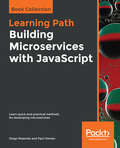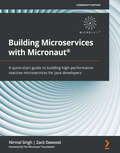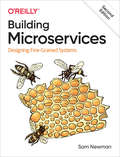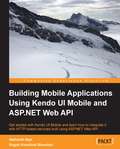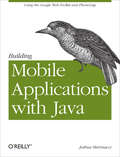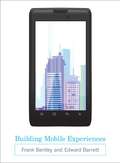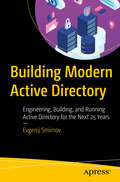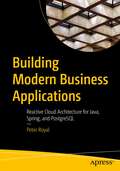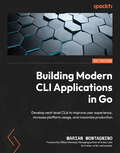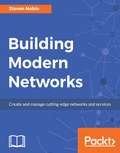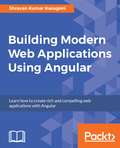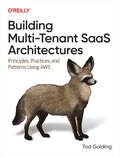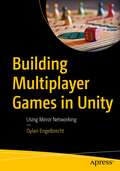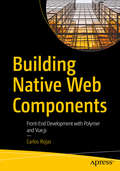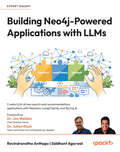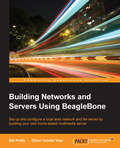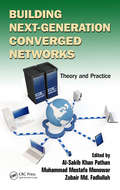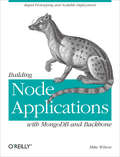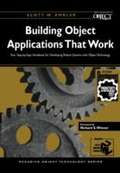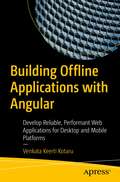- Table View
- List View
Building Microservices with JavaScript: Learn quick and practical methods for developing microservices
by Diogo Resende Paul OsmanExplore microservices by developing with Express, deploying with Docker, and scaling with Swarm and Kubernetes.Key FeaturesBuild cloud-native microservices using only Node and ExpressWrite clean and maintainable code with JavaScript for improved microservices developmentLearn ways to monitor and manage your services in a production environmentBook DescriptionMicroservices are a popular way to build distributed systems that power modern web and mobile apps. With the help of this Learning Path, you'll learn how to develop your applications as a suite of independently deployable and scalable services.Using an example-driven approach, this Learning Path will uncover how you can dismantle your monolithic application and embrace microservice architecture, right from architecting your services and modeling them to integrating them into your application. You’ll also explore ways to overcome challenges in testing and deploying these services by setting up deployment pipelines that break down the application development process into several stages. You’ll study serverless architecture for microservices and understand its benefits. Furthermore, this Learning Path delves into the patterns used for organizing services, helping you optimize request handling and processing. You'll then move on to learn the fault-tolerance and reliability patterns that help you use microservices to isolate failures in your applications.By the end of this Learning Path, you’ll have the skills necessary to build enterprise-ready applications using microservices.This Learning Path includes content from the following Packt products:Hands-On Microservices with Node.js by Diogo ResendeMicroservices Development Cookbook by Paul OsmanWhat you will learnUse Docker and Swarm for continuous deployment and scalingBuild and deploy cloud-native microservices and avoid vendor lock-inExplore different service architectures such as Hydra and SenecaCreate services that don’t impact users upon failureMonitor your services to perform debugging and create observable systemsDevelop fast and reliable deployment pipelinesManage multiple environments for your servicesSimplify the local development of microservice-based systemsWho this book is forIf you’re a JavaScript developer looking to put your skills to work by building microservices and moving away from the monolithic architecture, this book is for you. To understand the concepts explained in this Learning Path, you must have knowledge of Node.js and be familiar with the microservices architecture.
Building Microservices with Micronaut®: A quick-start guide to building high-performance reactive microservices for Java developers
by Nirmal Singh Zack Dawood A23 The Micronaut® FoundationExplore different aspects of building modular microservices such as development, testing, maintenance, and deployment using the Micronaut frameworkKey FeaturesLearn how to build scalable, fast, and resilient microservices with this concise guideExplore the many advantages of using reflection-free, compile-time dependency injections and aspect-oriented programmingBuild cloud-native applications easily with the Micronaut frameworkBook DescriptionThe Micronaut® open source software is a JVM-based framework, designed to create microservices quickly and easily. This book will help full-stack and Java developers to build modular, high-performing, and reactive microservice-based apps using Micronaut. You'll start by building microservices and learning about the core components of Micronaut, such as ahead-of-time compilation, reflection-less dependency injection, and reactive baked-in HTTP clients and servers. Next, you will work on a real-time microservice application and learn how to integrate Micronaut with different kinds of relational and non-relational databases. You'll also learn how to employ different security mechanisms to safeguard your microservices and integrate microservices using event-driven architecture in the Apache Kafka ecosystem. As you advance, you'll get to grips with automated testing and popular testing tools. The book will help you understand how you can easily handle microservice concerns in the Micronaut framework, such as service discovery, API documentation, distributed configuration management, fallbacks, and circuit breakers. Finally, you'll explore the deployment and maintenance aspects of microservices and get up to speed with the Internet of Things (IoT) using Micronaut. By the end of this book, you'll be able to build, test, deploy, and maintain your own microservice apps using Micronaut.What you will learnUnderstand why Micronaut is best suited for building microservicesBuild web endpoints and services in the Micronaut frameworkSafeguard microservices using Session, JWT, and OAuth in MicronautGet to grips with event-driven architecture in MicronautDiscover how to automate testing at various levels using built-in tools and testing frameworksDeploy your microservices to containers and cloud platformsBecome well-versed with distributed logging, tracing, and monitoring in MicronautGet hands-on with the IoT using Alexa and MicronautWho this book is forThis book is for developers who have been building microservices on traditional frameworks such as Spring Boot and are looking for a faster alternative. Intermediate-level knowledge of Java programming and implementing web services development in Java is required.
Building Microservices: Designing Fine-Grained Systems
by Sam NewmanDistributed systems have become more fine-grained in the past 10 years, shifting from code-heavy monolithic applications to smaller, self-contained microservices. But developing these systems brings its own set of headaches. With lots of examples and practical advice, this book takes a holistic view of the topics that system architects and administrators must consider when building, managing, and evolving microservice architectures.Microservice technologies are moving quickly. Author Sam Newman provides you with a firm grounding in the concepts while diving into current solutions for modeling, integrating, testing, deploying, and monitoring your own autonomous services. You'll follow a fictional company throughout the book to learn how building a microservice architecture affects a single domain.Discover how microservices allow you to align your system design with your organization's goalsLearn options for integrating a service with the rest of your systemTake an incremental approach when splitting monolithic codebasesDeploy individual microservices through continuous integrationExamine the complexities of testing and monitoring distributed servicesManage security with user-to-service and service-to-service modelsUnderstand the challenges of scaling microservice architectures
Building Microservices: Designing Fine-Grained Systems
by Sam NewmanAs organizations shift from monolithic applications to smaller, self-contained microservices, distributed systems have become more fine-grained. But developing these new systems brings its own host of problems. This expanded second edition takes a holistic view of topics that you need to consider when building, managing, and scaling microservices architectures.Through clear examples and practical advice, author Sam Newman gives everyone from architects and developers to testers and IT operators a firm grounding in the concepts. You'll dive into the latest solutions for modeling, integrating, testing, deploying, and monitoring your own autonomous services. Real-world cases reveal how organizations today manage to get the most out of these architectures.Microservices technologies continue to move quickly. This book brings you up to speed.Get new information on user interfaces, container orchestration, and serverlessAlign system design with your organization's goalsExplore options for integrating a service with your systemUnderstand how to independently deploy microservicesExamine the complexities of testing and monitoring distributed servicesManage security with expanded content around user-to-service and service-to-service models
Building Minecraft Server Modifications
by Cody M. SommerModifying Minecraft with the Bukkit API is a unique guide that will walk you through the entire process of developing mods for your Minecraft server.Modifying Minecraft with the Bukkit API is great for anyone who is interested in customizing their Minecraft server. Whether you are new to programming, Java, Bukkit, or even Minecraft itself, this book has you covered. All you need is a valid Minecraft account. If you are interested in software development then this book will help you get started. If you are simply interested in playing Minecraft with your friends then this book will help you make that experience even more enjoyable.
Building Minecraft Server Modifications - Second Edition
by Cody M. SommerCreate and customize your very own Minecraft server using Java and the Spigot API About This Book * Set up a Minecraft server that you control * Use object-oriented programming to modify Minecraft regardless of your level of experience * This interactive guide will help you create a unique experience for you and your friends Who This Book Is For This book is great for anyone who is interested in customizing their Minecraft server. Whether you are new to programming, Java, Bukkit, or even Minecraft itself, this book has you covered. All you need is a valid Minecraft account. If you are interested in programming as a career or hobby, this book will get you started. If you are simply interested in playing Minecraft with your friends, then this book will help you make that experience even more enjoyable. What You Will Learn * Install and run a Spigot server for free on your home PC * Adjust the server settings to customize Minecraft to your liking * Install an IDE and configure a project to write code * Install and test plugins on a Spigot server * Test your plugins through debugging the code * Program in game commands and permissions * Get to know advanced programming concepts such as event-driven programming, configuration files, saving/loading data, and scheduled tasks * Implement configuration files to make your plugins customizable * Save and load your plugin's data to persist across server restarts In Detail Minecraft is a sandbox game that allows you to play it in any way you want. Coupled with a multiplayer server powered by Spigot, you can customize the game even more! Using the Bukkit API, anyone interested in learning how to program can control their Minecraft world by developing server plugins. This book is a great introduction to software development through the wonderful world of Minecraft. We start by instructing you through how to set up your home PC for Minecraft server development. This includes an IDE complete with the required libraries as well as a Spigot server to test on. You will be guided through writing code for several different plugins. Each chapter teaches you new skills to create plugins of increasing complexity, and each plugin adds a new concept of the Bukkit API By the end of the book, you will have all the knowledge you need about the API to successfully create any type of plugin. You can then practice and build your Java skills through developing more mods for their server. Style and approach This hands-on guide is filled with interactive examples to help you modify Minecraft. Programming terms and concepts are explained along the way so even those who have never written code before can keep up.
Building Mobile Applications Using Kendo UI Mobile and ASP.NET Web API
by Nishanth Nair Ragini Kumbhat BhandariWith easy-to-follow, step-by-step and real-life examples, you will be building your own mobile applications in a matter of days using Kendo Mobile UI and ASP.NET Web API. If you are a web applications developer new to mobile applications development, then this book is for you. You will also benefit from this book if you have experience in mobile applications development and would like to explore the Kendo UI. A basic understanding of HTML, CSS, and jQuery is desirable to follow this book.
Building Mobile Applications with Java: Using the Google Web Toolkit and PhoneGap
by Joshua MarinacciDo you want to develop mobile apps with Java—and have them work on a variety of devices powered by iOS and Android? You’ve come to the right place.This project-driven book shows you how to build portable apps with two amazing open source frameworks, Google Web Tools (GWT) and PhoneGap. With these tools, you’ll use learn how to write Java code that compiles into cross-platform Javascript and HTML, and discover how to take advantage of features in several popular devices, such as the camera, accelerometer, and GPS.Get started with GWT by building an example Twitter search appBuild a example web app and adapt it for mobile with CSSAdd touch centric controls with the GWT Mobile UI libraryDevelop a working wine journal app that tracks a user’s GPS locationUse techniques to make a mobile version of your web or desktop appWork with HTML5 Canvas to build a mobile video gamePackage your apps for iOS, webOS, and Android with PhoneGap
Building Mobile Experiences
by Frank Bentley Edward BarrettThe mobile device is changing the ways we interact with each other and with the world. The mobile experience is distinct from the desktop or laptop experience; mobile apps require a significantly different design philosophy as well as design methods that reflect the unique experience of computing in the world. This book presents an approach to designing mobile media that takes advantage of the Internet-connected, context-aware, and media-sharing capabilities of mobile devices. It introduces tools that can be used at every stage of building a mobile application, from concept creation to commercialization, as well as real-world examples from industry and academia. The methods outlined apply user-centered design processes to mobile devices in a way that makes these methods relevant to the mobile experience--which involves the use of systems in the complex spatial and social world rather than at a desk. The book shows how each project begins with generative research into the practices and desires of a diverse set of potential users, which grounds research and design in the real world. It then describes methods for rapid prototyping, usability evaluation, field testing, and scaling up solutions in order to bring a product to market. Building Mobile Experiences grew out of an MIT course in communicating with mobile technology; it is appropriate for classroom use and as a reference for mobile app designers.
Building Modern Active Directory: Engineering, Building, and Running Active Directory for the Next 25 Years
by Evgenij SmirnovBreak the vicious circle of designs perpetuating the errors of the past and “just click next and accept the defaults” implementations preventing a secure and reliable future. This book looks at the typical patterns and antipatterns in Active Directory (AD) design, deployment, and operations and provides an approach to building and operating AD that is based on engineering (analyzing and fulfilling requirements) rather than design (formulating requirements). The book starts with an historical overview of AD and its future 25 years later. You then learn about the challenges that organizations running AD are facing today followed by understanding how to avoid them while learning modern requirements for more efficient and effective AD performance. After that, you go through business requirements influencing the AD topology along with ways to engineer information lookup to protect high-value objects. The book looks at two main protocols and the many dialects that AD offers to engineer an authentication service that fulfills modern requirements while leaving insecure legacy configurations behind. Managing AD from both the security and usability perspectives is discussed next in the book. Building, operating, and transitioning to a modern AD is demonstrated in detail. The book guides you with the next steps of your journey to achieve a secure and reliable AD. After reading this book, you will be able to bridge the gap between the two approaches by analyzing real-world business requirements, explaining the decision-making process in both design and engineering, and ultimately providing concrete engineering guidelines for typical implementation scenarios. What Will You Learn Build a modern Active Directory (AD), leaving behind design antipatterns that are not valid anymore Build a “secure by design” AD and accommodate legacy technology without compromising the overall security Understand advanced AD functionality such as controlling object visibility and partitioning Kerberos authentication by Authentication Policies Operate a modern AD, react to changing business requirements, and respond to ever-evolving security threats Who This Book Is For Active Directory (AD) architects and consultants who need to provide design and engineering advice to customers; AD administrators tasked with modernizing and securing AD in their organizations; security architects wishing to learn the AD design patterns to watch out for
Building Modern Business Applications: Reactive Cloud Architecture for Java, Spring, and PostgreSQL
by Peter RoyalDiscover a new way of thinking about business applications in light of the massive industry shift toward cloud computing and reactive programming technologies. This book synthesizes technologies and techniques such as event sourcing, command query responsibility segregation (CQRS), property-based testing, and GraphQL into a cohesive guide for modern business applications that benefit every developer.The book begins with a look at the fundamentals of modern business applications. These fundamentals include business rules and the managing of data over time. The benefits of reactive techniques are explained, including how they are fundamentally aligned with what application developers strive to achieve in their work.Author Peter Royal equips you with sound guidance to follow as you evolve your existing systems, as well as examples of how to build those systems using modern techniques in Spring, Java, and PostgreSQL.What You Will LearnArchitect business applications for cloud-based environmentsDesign sustainable business applicationsIntegrate GraphQL best practices into business applicationsUse property-based testing to exhaustively test possible system statesThink about business applications in terms of message flowsRelate the benefits of reactive systems to business goalsModel time appropriately for business requirementsWho This Book Is ForPracticing software developers who are building business applications, developers who are being asked to deploy into cloud environments that are more volatile than statically provisioned data centers, developers who want to increase the reliability of their systems and are struggling to find the right paradigms and architectures to achieve their goals, developers who see and use capabilities in software in other areas of their lives and want to bring those capabilities into their own work, and developers with experience designing other types of software who want to learn how to design business applications
Building Modern CLI Applications in Go: Develop next-level CLIs to improve user experience, increase platform usage, and maximize production
by Marian MontagninoEvolve the humble CLI using Go and unleash the next generation of powerful, flexible, and empathy-driven interfacesPurchase of the print or Kindle book includes a free PDF eBookKey FeaturesDiscover how Go enables the development of elegant and intuitive CLIsExplore a range of CLI development aspects and pick up a vast array of best practicesCreate engaging and user-friendly interfaces and learn how to distribute themBook DescriptionAlthough graphical user interfaces (GUIs) are intuitive and user-friendly, nothing beats a command-line interface (CLI) when it comes to productivity. Many organizations settle for a GUI without searching for alternatives that offer better accessibility and functionality. If this describes your organization, then pick up this book and get them to rethink that decision.Building Modern CLI Applications in Go will help you achieve an interface that rivals a GUI in elegance yet surpasses it in high-performance execution. Through its practical, step-by-step approach, you'll learn everything you need to harness the power and simplicity of the Go language to build CLI applications that revolutionize the way you work.After a primer on CLI standards and Go, you'll be launched into tool design and proper framework use for true development proficiency. The book then moves on to all things CLI, helping you master everything from arguments and flags to errors and API calls. Later, you'll dive into the nuances of empathic development so that you can ensure the best UX possible, before you finish up with build tags, cross-compilation, and container-based distribution.By the end of this UX book, you'll be fully equipped to take the performance and flexibility of your organization's applications to the next level.What you will learnMaster the Go code structure, testing, and other essentialsAdd a colorful dashboard to your CLI using engaging ASCII bannersUse Cobra, Viper, and other frameworks to give your CLI an edgeHandle inputs, API commands, errors, and timeouts like a proTarget builds for specific platforms the right way using build tagsBuild with empathy, using easy bug submission and tracebackContainerize, distribute, and publish your CLIs quickly and easilyWho this book is forThis book is for beginner- and intermediate-level Golang developers who take an interest in developing CLIs and enjoy learning by doing. You'll need an understanding of basic Golang programming concepts, but will require no prior knowledge of CLI design and development. This book helps you join a community of CLI developers and distribute within the popular Homebrew package management tool.
Building Modern Networks
by Steven NobleGain the edge with SDN, NFV, network virtualization, and networking on clouds About This Book • Navigate through the complexities of delivering modern networking services with practical techniques and solutions • Build robust software defined networks and solve real-world problems involving challenges with next generation networks • Discover the best practices used by top industry professionals for network-related architecture, services, and applications and secure your networks Who This Book Is For This book is for Network Engineers and Network Administrators who are taking their first steps when deploying software-defined networks. Network Architects will also find this book useful when designing and building modern networks. What You Will Learn • Understand Traditional Network Challenges to match modern applications requirements • Find out all about Next Generation Networks (NGN) • Explore the different APIs used to control NGN devices • Understand the different software controllers available to manage NGN hardware • Design a next generation network In Detail As IT infrastructures become more software-defined, networking operations tend to be more automated with falling levels of manual configuration at the hardware level. Building Modern Networks will brush up your knowledge on the modern networking concepts and help you apply them to your software-defined infrastructure. In this book you'll gain the knowledge necessary to evaluate, choose, and deploy a next generation network design. We will cover open and closed network operating systems (NOS) along with the protocols used to control them such as OpenFlow, Thrift, Opflex, and REST. You will also learn about traffic engineering and security concepts for NGNs. You will also find out how to fine-tune your network using QoS and QoE. By the end of the book, you'll be well versed in simplifying the way you design, build, operate, and troubleshoot your network. Style and Approach This practical tutorial shows you real-world solutions to design and build network services through cutting edge research.
Building Modern Web Applications Using Angular
by Shravan Kumar KasagoniDesign and develop next generation web applications using Angular 2 and Angular 4 About This Book • Learn about the core building blocks of Angular • Build and architect high performance web applications • Implement the latest JavaScript concepts in ECMAScript 2015, ECMAScript 2016, and TypeScript • Leverage the latest Angular features to get the most out of your web applications Who This Book Is For This book is targeted at JavaScript developers who are interested in learning how to build rich and powerful web applications with the latest version of Angular. Working knowledge of Angular 1 will be beneficial. What You Will Learn • Develop a frontend web application using component-based architecture • Use ES5, ES2015, and TypeScript to build Angular 4 UI applications • Develop simple to complex user interfaces in Angular 4 • Develop and handle forms in Angular 4 UI applications • Test UIs built in Angular 4 • Use material design components and animations in Angular 4 In Detail In the last few years, Angular has established itself as the number one choice of JavaScript Developers. What makes Angular special is performance and productivity. With Angular, developers can work on consistent coding patterns and build web applications that are powerful and scalable. This book will you get you up and running with Angular and teach how to build modern web applications. It starts with basics of Angular 2 and then brushes you up with the new features of Angular 4. You will learn the core concepts involved in building web applications with Angular such as Data Binding, Routing, Dependency Injection, and much more. The book teaches how to build components and use them to build web apps of your choice. It will help you to handle different kinds of forms and learn the concept of reactive programming. Finally the book teaches how to build visually appealing and responsive UIs. Style and approach It follows a practical approach to explain almost every feature of Angular 2 and Angular 4 and their concepts through real-world examples. In each chapter, a different example is used so that you can build a foundation and understand the concepts by applying them in different scenarios.
Building Modular Cloud Apps with OSGi: Practical Modularity with Java in the Cloud Age
by Paul Bakker Bert ErtmanIf you’re an experienced Java developer in the enterprise, this practical, hands-on book shows you how to use OSGi to design, develop, and deploy modular cloud applications. You’ll quickly learn how to use OSGi, through concise code examples and a set of best practices derived from the authors’ experiences with real-world projects.Through the course of this book, you’ll learn to develop modern web applications with tools and techniques such as RESTful Web Services, NoSQL, provisioning, elasticity, Auto Scaling, hotfixes, and automatic failover. Code samples are available from GitHub.Work with dynamic OSGi services to create modular applicationsExplore the basics of OSGi bundles and modular application designLearn advanced topics, including semantic versioning, integration testing, and configuring componentsUnderstand OSGi pitfalls, anti-patterns, and features you should avoidCreate a modular architecture for cloud-based web applicationsDiscover how maintainability, extensibility, scalability, and testability are affected by modular designGet a look at various options for creating web applications with a modular approachInteract with persistent storage services, including relational databases and NoSQLExamine alternatives for deploying modular applications to the cloud
Building Multi-Tenant SaaS Architectures: Principles, Practices, and Patterns Using AWS
by Tod GoldingSoftware as a service (SaaS) is on the path to becoming the de facto model for building, delivering, and operating software solutions. Adopting a multi-tenant SaaS model requires builders to take on a broad range of new architecture, implementation, and operational challenges. How data is partitioned, how resources are isolated, how tenants are authenticated, how microservices are built—these are just a few of the many areas that need to be on your radar when you're designing and creating SaaS offerings.In this book, Tod Golding, a global SaaS technical lead at AWS, provides an end-to-end view of the SaaS architectural landscape, outlining the practical techniques, strategies, and patterns that every architect must navigate as part of building a SaaS environment.Describe, classify, and characterize core SaaS patterns and strategiesIdentify the key building blocks, trade-offs, and considerations that will shape the design and implementation of your multi-tenant solutionExamine essential multi-tenant architecture strategies, including tenant isolation, noisy neighbor, data partitioning, onboarding, identity, and multi-tenant DevOpsExplore how multi-tenancy influences the design and implementation of microservicesLearn how multi-tenancy shapes the operational footprint of your SaaS environment
Building Multicopter Video Drones
by Ty AudronisThis book is for a wide range of individuals who are looking to shoot aerial footage with a multicopter. No previous flying experience is assumed, but even the most expert flyers will find unexpected and interesting information.
Building Multiplayer Games in Unity: Using Mirror Networking
by Dylan EngelbrechtTake a deep dive into creating large-scale, multiplayer games with Unity 3D, using Mirror Networking and a variety of powerful transports. You will learn the fundamentals of RPC/Command multiplayer architecture and dig deeper into networking and data persistence to achieve scalable, highly performant, large-scale, multiplayer games in Unity.This book explains how to develop multiplayer games using Unity within a commercial or enterprise environment. You will take a look at the networking fundamentals behind multiplayer games, including packets and the importance of keeping packets small. Next, you will look into Mirror Networking and see how to leverage a variety of transport layers to achieve large-scale, multiplayer games. Using Unity 3D as the core focus, you will get an understanding of the RPC/Command architecture and how you can utilize different authoritative structures to best suit your needs. You will also learn how to scale your architecture and explore industry-leading methods of deploying your game to the masses. You will also get a solid understanding of networking principles. The book wraps up with advice from leading experts who shed light on past mistakes and provide valuable insights for your next project. This book breaks down daunting concepts into easy-to-understand pieces of knowledge to help you create your first multiplayer game. It is a must-read for any developer looking to understand multiplayer games and networking.What You Will Learn● Learn advanced multiplayer concepts and how to use them● Understand the key concepts for creating multiplayer virtual experiences● Know the basics of computer networking and how to employ them● Deploy large, scalable multiplayer infrastructures for your games● Gain insights from other industry professionalsWho Is This Book ForIntermediate to advanced Unity 3D developers looking to understand multiplayer networking and deploying large-scale products. Having a solid understanding of C# and Unity is required, and having an understanding or prior experience with networking principles such as IPv4 would be advantageous.
Building Native Web Components: Front-End Development with Polymer and Vue.js
by Carlos RojasStart developing single-page applications (SPAs) with modern architecture. This book shows you how to create, design, and publish native web components, ultimately allowing you to piece together those elements in a modern JavaScript framework. Building Native Web Components dives right in and gets you started building your first web component. You’ll be introduced to native web component design systems and frameworks and discuss component-driven development to understand its importance in large-scale companies. You’ll then move on to building web components using templates and APIs, and custom event lifecycles. Techniques and best practices for moving data, customizing, and distributing components are also covered. Throughout, you’ll develop a foundation to start using Polymer, Vue.js, and Firebase in your day-to-day work. Confidently apply modern patterns and develop workflows to build agnostic software pieces that can be reused in SPAs. Building Native Web Components is your guide to developing small and autonomous web components that are focused, independent, reusable, testable, and works with all JavaScript frameworks, modern browsers, and libraries.What You Will LearnIncorporate component-driven development (CDD) and design systems into your workflowBuild apps with reusable UI components that are agnostic to JavaScript frameworksUtilize Polymer and Vue.js in your day-to-day workPublish your UI components in npm (Node Package Manager) Who This Book Is For The book is intended for Intermediate–Advanced level readers interested in single-page applications (SPAs), as well as Polymer, Vue.js, and Firebase.
Building Neo4j-Powered Applications with LLMs: Create LLM-driven search and recommendations applications with Haystack, LangChain4j, and Spring AI
by Ravindranatha Anthapu Siddhant AgarwalA comprehensive guide to building cutting-edge generative AI applications using Neo4j's knowledge graphs and vector search capabilitiesKey FeaturesDesign vector search and recommendation systems with LLMs using Neo4j GenAI, Haystack, Spring AI, and LangChain4jApply best practices for graph exploration, modeling, reasoning, and performance optimizationBuild and consume Neo4j knowledge graphs and deploy your GenAI apps to Google CloudPurchase of the print or Kindle book includes a free PDF eBookBook DescriptionEmbark on an expert-led journey into building LLM-powered applications using Retrieval-Augmented Generation (RAG) and Neo4j knowledge graphs. Written by Ravindranatha Anthapu, Principal Consultant at Neo4j, and Siddhant Agrawal, a Google Developer Expert in GenAI, this comprehensive guide is your starting point for exploring alternatives to LangChain, covering frameworks such as Haystack, Spring AI, and LangChain4j. As LLMs (large language models) reshape how businesses interact with customers, this book helps you develop intelligent applications using RAG architecture and knowledge graphs, with a strong focus on overcoming one of AI’s most persistent challenges—mitigating hallucinations. You'll learn how to model and construct Neo4j knowledge graphs with Cypher to enhance the accuracy and relevance of LLM responses. Through real-world use cases like vector-powered search and personalized recommendations, the authors help you build hands-on experience with Neo4j GenAI integrations across Haystack and Spring AI. With access to a companion GitHub repository, you’ll work through code-heavy examples to confidently build and deploy GenAI apps on Google Cloud. By the end of this book, you’ll have the skills to ground LLMs with RAG and Neo4j, optimize graph performance, and strategically select the right cloud platform for your GenAI applications.What you will learnDesign, populate, and integrate a Neo4j knowledge graph with RAGModel data for knowledge graphsIntegrate AI-powered search to enhance knowledge explorationMaintain and monitor your AI search application with HaystackUse LangChain4j and Spring AI for recommendations and personalizationSeamlessly deploy your applications to Google Cloud PlatformWho this book is forThis LLM book is for database developers and data scientists who want to leverage knowledge graphs with Neo4j and its vector search capabilities to build intelligent search and recommendation systems. Working knowledge of Python and Java is essential to follow along. Familiarity with Neo4j, the Cypher query language, and fundamental concepts of databases will come in handy.
Building Networks and Servers Using BeagleBone
by Bill Pretty Glenn Vander VeerIf you are a developer with BeagleBone experience and want to learn how to use it to set up a network and file server, then this book is ideal for you. To make the most of this book, you should be comfortable with the Linux operating system and know how to install software from the Internet, but you do not have to be a network guru.
Building Next-Generation Converged Networks: Theory and Practice
by Zubair Md. Fadlullah Al-Sakib Khan Pathan Muhammad Mostafa MonowarSupplying a comprehensive introduction to next-generation networks, Building Next-Generation Converged Networks: Theory and Practice strikes a balance between how and why things work and how to make them work. It compiles recent advancements along with basic issues from the wide range of fields related to next generation networks. Containing the co
Building Node Applications with MongoDB and Backbone: Rapid Prototyping and Scalable Deployment
by Mike WilsonBuild an application from backend to browser with Node.js, and kick open the doors to real-time event programming. With this hands-on book, you’ll learn how to create a social network application similar to LinkedIn and Facebook, but with a real-time twist. And you’ll build it with just one programming language: JavaScript.If you’re an experienced web developer unfamiliar with JavaScript, the book’s first section introduces you to the project’s core technologies: Node.js, Backbone.js, and the MongoDB data store. You’ll then launch into the project—a highly responsive, highly scalable application—guided by clear explanations and lots of code examples.Learn about key modules in Node.js for building real-time appsUse the Backbone.js framework to write clean browser code, and maintain better data integration with MongoDBStructure project files as a foundation for code that will arrive laterCreate user accounts and learn how to secure the dataUse Backbone.js templates to build the application’s UIs, and integrate access control with Node.jsDevelop a contact list to help users link to and track other accountsUse Socket.io to create real-time chat functionalityExtend your UIs to give users up-to-the-minute information
Building Object Applications That Work: Your Step-by-Step Handbook for Developing Robust Systems with Object Technology
by Scott W. AmblerA must-have resource for designers and testers of today's OO applications, the book takes you thru the entire process of building object applications.
Building Offline Applications with Angular: Develop Reliable, Performant Web Applications for Desktop and Mobile Platforms
by Venkata Keerti KotaruGet a complete overview of offline installable applications. Businesses need reliable applications that enable users to access data and their applications in spite of a bad network connection. Traditional websites work only when connected to the network. With a large number of users depending on mobile phones and tablets for work, social interactions, and media consumption, it’s important that the web applications can work on a weak network connection and even offline. This step-by-step guide shows you how to build an Angular application that considers offline access and uses its ready-made features and configurations. Build Offline Applications with Angular helps bridge the gap between native apps and web applications.What You Will LearnGet started with an installable Angular applicationUnderstand the importance of performant, reliable, and offline access of a web applicationDiscover solutions for building Angular applications for speedy response in low bandwidth scenariosUse IndexedDB as an offline data store within a browserWho Is This Book ForIdeal for beginner-to-intermediate-level readers with basic understanding of JavaScript and Angular.
